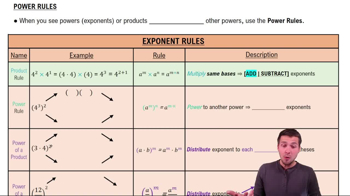Table of contents
- 0. Functions7h 52m
- Introduction to Functions16m
- Piecewise Functions10m
- Properties of Functions9m
- Common Functions1h 8m
- Transformations5m
- Combining Functions27m
- Exponent rules32m
- Exponential Functions28m
- Logarithmic Functions24m
- Properties of Logarithms34m
- Exponential & Logarithmic Equations35m
- Introduction to Trigonometric Functions38m
- Graphs of Trigonometric Functions44m
- Trigonometric Identities47m
- Inverse Trigonometric Functions48m
- 1. Limits and Continuity2h 2m
- 2. Intro to Derivatives1h 33m
- 3. Techniques of Differentiation3h 18m
- 4. Applications of Derivatives2h 38m
- 5. Graphical Applications of Derivatives6h 2m
- 6. Derivatives of Inverse, Exponential, & Logarithmic Functions2h 37m
- 7. Antiderivatives & Indefinite Integrals1h 26m
- 8. Definite Integrals4h 44m
- 9. Graphical Applications of Integrals2h 27m
- 10. Physics Applications of Integrals 2h 22m
3. Techniques of Differentiation
The Chain Rule
Problem 47
Textbook Question
Calculate the derivative of the following functions.
y = (1 + 2 tan u)4.5
 Verified step by step guidance
Verified step by step guidance1
Step 1: Identify the function y = (1 + 2 \tan u)^{4.5} as a composite function, which requires the use of the chain rule to differentiate.
Step 2: Apply the chain rule. The chain rule states that if you have a composite function y = f(g(u)), then the derivative y' is f'(g(u)) * g'(u).
Step 3: Differentiate the outer function f(v) = v^{4.5} with respect to v, which gives f'(v) = 4.5v^{3.5}.
Step 4: Differentiate the inner function g(u) = 1 + 2 \tan u with respect to u, which gives g'(u) = 2 \sec^2 u.
Step 5: Combine the results from Steps 3 and 4 using the chain rule: y' = 4.5(1 + 2 \tan u)^{3.5} \cdot 2 \sec^2 u.
 Verified video answer for a similar problem:
Verified video answer for a similar problem:This video solution was recommended by our tutors as helpful for the problem above
Video duration:
3mPlay a video:
Was this helpful?
Key Concepts
Here are the essential concepts you must grasp in order to answer the question correctly.
Derivative
The derivative of a function measures how the function's output value changes as its input value changes. It is a fundamental concept in calculus that represents the slope of the tangent line to the curve of the function at any given point. Derivatives are used to find rates of change and can be calculated using various rules, such as the power rule, product rule, and chain rule.
Recommended video:

Derivatives
Chain Rule
The chain rule is a formula for computing the derivative of a composite function. If a function y is defined as a function of u, which is itself a function of x, the chain rule states that the derivative of y with respect to x is the product of the derivative of y with respect to u and the derivative of u with respect to x. This is essential for differentiating functions like y = (1 + 2 tan u)^(4.5), where the inner function (1 + 2 tan u) is raised to a power.
Recommended video:

Intro to the Chain Rule
Power Rule
The power rule is a basic rule for finding the derivative of a function in the form of y = x^n, where n is a real number. According to this rule, the derivative is given by dy/dx = n*x^(n-1). This rule simplifies the process of differentiation, especially when dealing with polynomial functions or functions raised to a power, making it a crucial tool in calculus.
Recommended video:
Guided course

Power Rules

 5:02m
5:02mWatch next
Master Intro to the Chain Rule with a bite sized video explanation from Callie
Start learningRelated Videos
Related Practice






